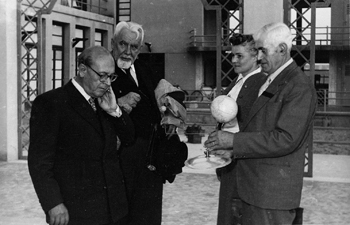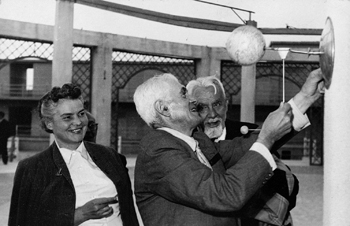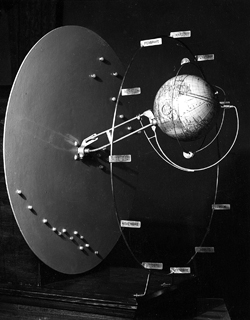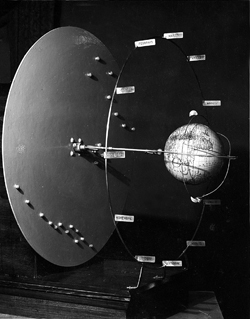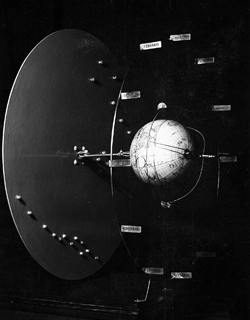|
|
| |
 |
| |
Of all the insights born of the creative mind of Silvio Corradi, the most significant and yet most remarkable was that in the area of astronomy.
After many years of direct observation of celestial phenomena he developed a new theory in contrast with that of Copernicus, which for hundreds of years had been recognized by mainstream science and taught in schools.
The new theory was presented to the Congress of the Italian Society for the Advancement of Science in Lucca on October 2, 1950 and brought him to Paris in 1952, to receive a bronze medal at the National Congress of Inventors. This yet again demonstrates how he was appreciated more abroad than in Italy.
For Silvio Corradi, used to ask questions starting with evidence, many aspects of the Copernicus theory were not convincing and could not find adequate answers to many questions.
• Why is the axis of rotation always defined parallel to itself and yet converges on the North Star?
• Why is it that in experimental or graphical representations of the motion of revolution proportions between the Earth and the Sun are never respected?
• Why do we not see the apparent movement of the constellations that should be determined by the effect of the motion of revolution, as we see the apparent motion of constellations due to the rotation motion?
• Why are simultaneous planetary motions of rotation and revolution of the Earth and the motions of other heavenly bodies not shown in planetariums?
|
|
|
|
| |
|
• How can two speeds so different yet simultaneous as rotational motion and the motion of revolution be matched?
• How can the Earth oscillate on its axis, as has been observed, while speeding at 100,000 kms. per hour?
• Why does the speed variation of the Earth in revolution motion, faster at perihelion (the end of December) and slower at aphelion (early July) when the orbit is nearly circular last only a few days, and the solar mass is so great?
• Where is the Sun positioned so that the earth might revolve around it and at the same time allow us to see every night in those areas of the sky containing the North Star?
• How does the Moon circling the Earth at a speed of 1 km per second simultaneously follow its vertiginous course around the sun, 30 times faster?
Finding no replies inside the Copernicus theory consistent with his direct and meticulously annotated observations, Silvio Corradi formulated a new hypothesis that at the end of hard work led him to develop a totally new astronomical theory, in which every movement was supposed to be ascertained through direct observation.
In addressing this topic, Silvio Corradi felt encouraged that other researchers had raised similar doubts. In particular, he liked to quote Professor Armellini, who during a congress of science and technology had declared: "To demonstrate the difficulty of the great problem of the Universe, most mechanical models have fallen, wich researchers had imagined in past generations, in order to explain in an imaginable way the behaviour of the fundamental laws of nature. " In this speech he was echoed by Professor Fantappié: "If there is a sensible model that can reconcile apparently contraddictory facts, we will give up these models and classify the facts themselves in a pattern that is logically complete and clear"
And it was looking for a logically complete scheme that Corradi developed his personal plan of a planetarium capable of representing simultaneously all the celestial motions from the Stars to the Sun, to the Earth and the Moon.
This planetarium brought him the bronze medal at the congress in Paris and consideration for possible adoption in state schools, by the then French minister of culture who perhaps had considered the instrument but not the theory explained. Silvio Corradi states that the Earth does not revolve around the Sun but in front of the Sun
The earth describes an orbit much smaller and moves much more slowly.
The earth's axis to the north, where it concentrates more weight due to the presence of the large masses of the continents appears to be tilted about 23 degrees with respect to the south, where there is a greater presence of large masses of water and is therefore lighter. |
|
| |
The motion of rotation, given the weight difference of the two hemispheres clashes with a different resistance, determining a conical movement, which has as its summit the North Star.
The earth’s speed of translation motion is less than the speed of rotation, which explains all the phenomena that we can observe such as the fact that the circumpolar constellations are moving due to the annual translation movement of the Earth. The inclination of the axis explains why one hemisphere is more enlightened than the other.
The Sun has a dual effect on the Earth, attractive and repulsive.
From June to December, the Earth has towards the Sun the great masses of water that absorb heat, causing the action of attraction of the sun. From December to June the sun rays hit the continents, reflecting almost entirely the heat resulting in a repulsive action. |
| |
For the Copernicus theory, the Earth revolves around the Sun and its axis, in making the revolution motion, is always parallel to itself while pointing to the North star, that “for necessity” is considered at infinity, i.e. at a point where we can say that parallels meet.
Silvio Corradi objected. If the light of the star arrives to us it necessarily means that it travels a finite distance. According to Corradi’s theory the axis of the Earth in translation motion assumes positions that create the shape of a cone whose apex is the North Star. The direct observation confirms this.
To explain how it is possible to reconcile the parallel axis with its convergence on the Pole Star he loved to evoke the image of some hunters who positioned a short distance one from another and with rifles positioned in parallel are invited to point at the North star. Only one hunter would hit the target because, having assumed parallel positions, only one would be correctly aligned. Another image he used to make people understand the true motions of the Earth was to compare it with a huge orange on which 24 incisions had been made on the peel corresponding exactly to the 24 segments below, whose skin becomes transparent and leaves the fruit increasing in volume as does a soap bubble without losing its shape or the division into 24 shares, and thus becomes the representation of the celestial sphere. The 24 slices of orange correspond to the Earths time zones and the 24 pieces of rind to the celestial time zones, which can be marked permanently because they remain fixed.
In the heavenly time zone at 12 o'clock we put the sun.
The Earth turning on itself shifts time zones that owe their time to their position relative to the Sun.
The phenomenon of the tides which is closely tied to time is not due to the influence of the moon as it has always been thought. |
| |
| |
The Moon takes 29 days to complete its circle around the earth, while the tides alternate 4 times within 24 hours. The conditions that cause the tides are present on the 4 zones and can be observed in any area of the sea or ocean. Hence the waters of the sea will be influenced by forces that exert their influence at equal rates.
Silvio Corradi’s theory explains that the tides are due to the Sun More precisely, the low tide is due to the heat of the sun expanding the atmosphere and causing compression of the water, while at the opposite side of Earth natural gravitation exerts a similar pressure. The two zones of low tide generate high tide in the two intermediate opposing zones as a logical outlet for the expansion of the water compressed.
The Copernicus theory describes a motion of the moon that is not found in reality. The sinusoidal wave travelled by the Moon, in the transition from first to last quarter, should follow the same direction as the rotation of the Earth (from west to east) whilst from the last to first quarter (the phase of the new moon) should reverse the direction of rotation in relation to our planet and this does not happen.
The movement of the moon always follows the same sense of rotation of the Earth and throughout the year the terrestrial meridians meet the four phases, constantly placing the tides at six hours distance between them. |
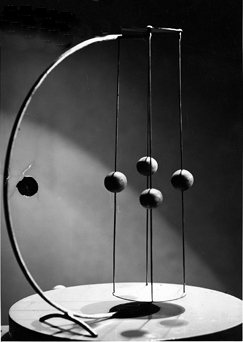 |
|
| |
To complete this brief explanation of the theories of Silvio Corradi some thoughts on the motion of translation, on the celestial vault and the constellations. As already stated in this model the Earth is fixed to the north celestial pole, the Earth's axis never abandoning the Pole Star. The axis from the south pole, if theoretically prolonged does not locate a single star, but a circumpolar area, far from the theoretical celestial South pole, the location of the Southern Cross constellation. Its motion reflects the annual motion of the Earth. Its trajectory is contained in the same plane containing the ecliptic and the centre of the sun.
With this motion the Earth approaches and moves away from the Sun and the effect of the axis inclination exposes to the direct rays of the sun first the southern hemisphere then the northern hemisphere.
The annual movement sees the change of the seasons and brings the world to visit the 12 constellations of the Zodiac. So while the earth, during 6 months visits six constellations of the night hemisphere, the sun visits the other six opposite constellations of the day hemisphere.
The rotation and translation motion create two movements observable across the sky: one for each day and one per year that correspond perfectly and this ensures that the Sun is not the centre of these movements. |
| |
Silvio Corradi, the scientist from Vigatto,in the course of numerous Italian and international conferences, with his planetarium at hand tried to open a dialogue with other astronomers and scientists who should have opposed his theories. But no one was ever able to pose concrete and plausible opposing arguments like his typical tangible examples.
It is natural to ask if anyone has ever asked the same questions, and if so what replies they concluded. It is equally natural to hope that there may be someone willing to consider the theory of Silvio Corradi without preconceptions, to check his statements through direct observation and be willing to take up the challenge he launched to researchers and astronomers to dismantle his theory with empirical arguments. |
| |
|
|
